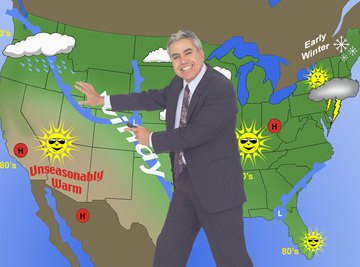
Frontal boundaries on weather maps denote an abrupt change in air mass. Warm fronts and cold fronts are the two most common types of frontal boundaries. Cold air masses generally move south and southeastward across the United States while warm air masses move north and northeastward. Cold frontal boundaries typically move faster than warm frontal boundaries. Fronts are identified on a weather map by a sharp temperature gradient, a sharp moisture gradient or a sharp change in wind direction.
- Surface weather map
- Colored pencils
Cold frontal boundaries can also be identified by a rapid temperature drop behind the wind shift. Also, cloud cover typically decreases and clear skies are observed. Warm frontal boundaries can also be identified by a temperature rise after the front has passed, and may or may not be associated with clearing skies.
Pull out a current surface weather map. A surface weather map will tell you the temperature, wind speed and direction, barometric pressure, precipitation and cloud cover of many weather sites across a region.
Identify possible cold frontal boundaries. Cold frontal boundaries are identified by a wind shift from south and southwest to north and northwest. These fronts usually extend south or southwestward from a low pressure system. Draw the boundary as a blue line with triangles on it. The line will run between the different noted wind directions.
Identify possible warm frontal boundaries. Warm frontal boundaries are identified by a wind shift from east and southeast to south and southwest. They usually extend eastward out from a low pressure system. Draw the boundary as a red line with bumps on it. The line will run between the different noted wind directions.
Things You'll Need
Tips
References
Tips
- Cold frontal boundaries can also be identified by a rapid temperature drop behind the wind shift. Also, cloud cover typically decreases and clear skies are observed.
- Warm frontal boundaries can also be identified by a temperature rise after the front has passed, and may or may not be associated with clearing skies.
Photo Credits
SW Productions/Brand X Pictures/Getty Images
